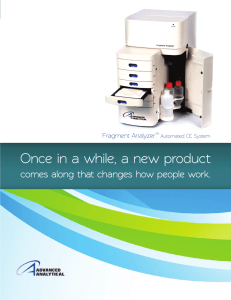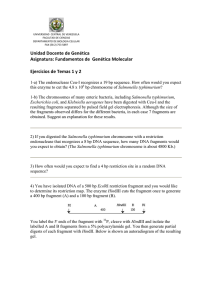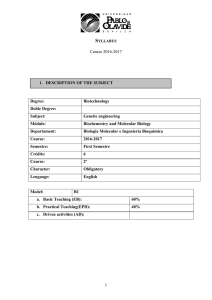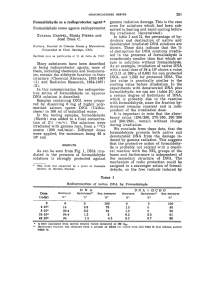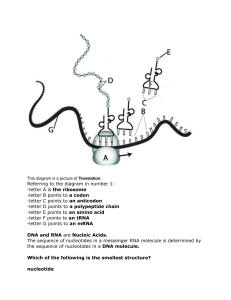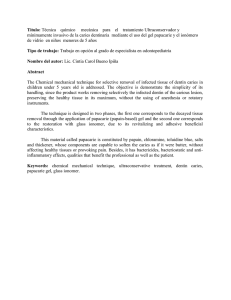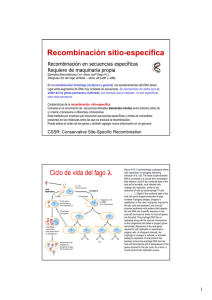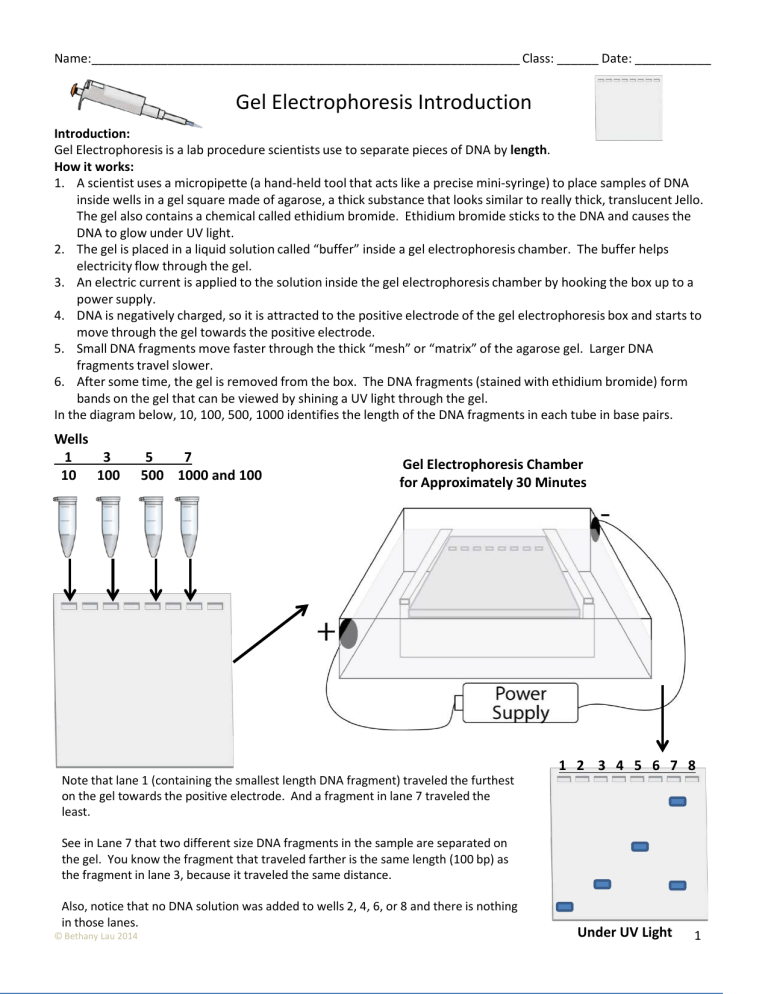
Name:______________________________________________________________ Class: ______ Date: ___________ Gel Electrophoresis Introduction Introduction: Gel Electrophoresis is a lab procedure scientists use to separate pieces of DNA by length. How it works: 1. A scientist uses a micropipette (a hand-held tool that acts like a precise mini-syringe) to place samples of DNA inside wells in a gel square made of agarose, a thick substance that looks similar to really thick, translucent Jello. The gel also contains a chemical called ethidium bromide. Ethidium bromide sticks to the DNA and causes the DNA to glow under UV light. 2. The gel is placed in a liquid solution called “buffer” inside a gel electrophoresis chamber. The buffer helps electricity flow through the gel. 3. An electric current is applied to the solution inside the gel electrophoresis chamber by hooking the box up to a power supply. 4. DNA is negatively charged, so it is attracted to the positive electrode of the gel electrophoresis box and starts to move through the gel towards the positive electrode. 5. Small DNA fragments move faster through the thick “mesh” or “matrix” of the agarose gel. Larger DNA fragments travel slower. 6. After some time, the gel is removed from the box. The DNA fragments (stained with ethidium bromide) form bands on the gel that can be viewed by shining a UV light through the gel. In the diagram below, 10, 100, 500, 1000 identifies the length of the DNA fragments in each tube in base pairs. Wells 1 3 10 100 5 7 500 1000 and 100 Gel Electrophoresis Chamber for Approximately 30 Minutes Note that lane 1 (containing the smallest length DNA fragment) traveled the furthest on the gel towards the positive electrode. And a fragment in lane 7 traveled the least. 1 2 3 4 5 6 7 8 See in Lane 7 that two different size DNA fragments in the sample are separated on the gel. You know the fragment that traveled farther is the same length (100 bp) as the fragment in lane 3, because it traveled the same distance. Also, notice that no DNA solution was added to wells 2, 4, 6, or 8 and there is nothing in those lanes. © Bethany Lau 2014 Under UV Light 1 Name:______________________________________________________________ Class: ______ Date: ___________ Gel Electrophoresis is useful in identifying the size of an unknown DNA fragment. Scientists compare unknown DNA samples to a control sample called a marker sample or a “ladder”. The ladder sample contains several known lengths of DNA. In the example below, the ladder contains known fragments of DNA with lengths 100, 300, 500, 800, 1000, and 2000 base pairs long. Wells/Lanes # 1 3 5 Ladder ? ? 7 ? Gel Electrophoresis Chamber for Approximately 30 Minutes Under UV Light 1 Because we know the ladder’s standard fragment size, we can use this to estimate the unknown fragments in lanes 3, 5, and 7. In Lane 3, there are at least 2 different fragments: one has a length of between 1000 and 2000 bp. One has a length close to 800 bp. In Lane 5, there are at least 3 different DNA fragments. One is about 800 bp, one is between 300 and 500 (estimate 400), and one is about 300 bp. In Lane 7, there is at least 1 fragment that is close to 100 base pairs in length. 2 3 4 5 6 7 8 2000 1000 800 500 300 100 It is important to note what DNA gel electrophoresis cannot do. When reading a DNA gel’s bands, you cannot know if a sample has 2 or more different fragments of the same length. In the gel above, lane 7 might have 1, 2, 3, 4, or many different DNA fragments with different sequences of very similar length (around 100 bp). There is no way to distinguish between different DNA fragments with the same length using just DNA gel electrophoresis. © Bethany Lau 2014 2 Name:______________________________________________________________ Class: ______ Date: ___________ Gel Electrophoresis Questions #1 Answer the following in complete sentences. 1. What tool is used to transfer small liquid solutions of DNA from tubes into the gel? _______________________________________________________________________________________________ 2. What causes the DNA fragments to move within the gel? _______________________________________________________________________________________________ _______________________________________________________________________________________________ 3. Which DNA fragments move faster? Which DNA fragments move slower? _______________________________________________________________________________________________ _______________________________________________________________________________________________ 4. What causes the normally colorless DNA to glow under UV light? _______________________________________________________________________________________________ 5. What is the purpose of using a marker or ladder in one lane on your gel? _______________________________________________________________________________________________ _______________________________________________________________________________________________ 6. In the table below, estimate the lengths of DNA fragments in each lane. Lane 8 has your marker and the lengths are written on the right. Sample 1 2 DNA Fragment Sizes 1 2 3 4 5 6 7 8 2000 1000 800 3 4 500 5 300 6 7 © Bethany Lau 2014 100 3 Name:______________________________________________________________ Class: ______ Date: ___________ Gel Electrophoresis Questions #2 Answer the following in complete sentences. 7. In another experiment, you plan to run a gel on a set of samples. Use the table below with DNA fragment lengths and draw the bands on the gel. The marker bands are completed for you in lane 8. 1 Sample DNA Fragment Sizes 1 300 2 1000, 200 3 100, 200, 300 4 700, 900, 1500 5 50 6 2000, 900 7 3000 2 3 4 5 6 7 8 2000 1000 800 500 300 100 8. What would you expect to happen if you left the gel accidentally in the gel electrophoresis chamber for too long? _______________________________________________________________________________________________ _______________________________________________________________________________________________ 9. A student makes a new gel using agarose, water, and buffer solution. The student loads their DNA samples in their wells and places the gel in the chamber for an appropriate length of time. When the student places the gel on the UV lightbox, no DNA bands show up at all. Even the marker lane is clear and has no bands! What mistake did the student make? Explain your answer. _______________________________________________________________________________________________ _______________________________________________________________________________________________ _______________________________________________________________________________________________ _______________________________________________________________________________________________ © Bethany Lau 2014 4 Name:______________________________________________________________ Class: ______ Date: ___________ Polymerase Chain Reaction (PCR) Introduction Introduction: When a DNA sample is collected from an organism or from a crime scene, there is often very little DNA in the collected sample. If there are only a few desired DNA fragments in a sample placed in a gel, there will not be enough DNA to form a band on the gel. Scientists need millions of copies of the sequence they want to study. Scientists can use Polymerase Chain Reaction (PCR for short) to amplify a specific sequence, or make many, many copies of the particular fragment they are interested in. To do a PCR reaction, the scientist must know the sequence of the ends of the DNA fragment he/she is interested in. The scientists designs small pieces of RNA called primers that can base-pair to the ends of the desired fragment. These RNA primers mark the ends of the segment the scientist wants to study and tell the reaction what DNA fragment to copy. In the diagram below, the double line represents the DNA strand, arrows represent the RNA primers, and the small vertical lines represent base-pairs between the primer and the DNA strand. The scientist also adds water, spare nucleotides, and an enzyme that copies DNA. Initial Sample (only a few copies in scientist’s sample) Inside the tubes in the PCR machine called a thermal cycler, multiple complex steps take place over the course of a few hours to copy the sequence many times. PCR product: Millions of copies of the desired fragment between and including the sequences that base-paired with the RNA primers in the tube Remember: Often the initial sample has other DNA that the scientist doesn’t want to study. By performing the PCR reaction, the scientist makes copies of the DNA fragment that he/she does want to study. The DNA that the scientist doesn’t want to study is still in the product tube, but only in small numbers. The desired fragment will outnumber the undesired DNA by millions to 1. Once the scientist has a tube containing millions of copies of the DNA (s)he wants to study, the DNA can be isolated on a DNA gel using a process called DNA gel electrophoresis. © Bethany Lau 2014 5 Name:______________________________________________________________ Class: ______ Date: ___________ Polymerase Chain Reaction (PCR) Questions Answer the following questions in complete sentences. 1. In what situation do scientists need to use the PCR reaction? _______________________________________________________________________________________________ _______________________________________________________________________________________________ _______________________________________________________________________________________________ 2. Make a list of the chemicals and reactants go into the tube before it goes in the PCR machine. ______________________________________________________ ______________________________________________________ ______________________________________________________ ______________________________________________________ 3. What is the PCR machine called? ________________________________________________________________ 4. What is the purpose of the RNA primers in the reaction? _______________________________________________________________________________________________ _______________________________________________________________________________________________ 5. How can scientists see what is in their reaction tube after the PCR reaction? _______________________________________________________________________________________________ _______________________________________________________________________________________________ 6. Why are the spare nucleotides needed in the reaction? _______________________________________________________________________________________________ _______________________________________________________________________________________________ 7. What would you expect would happen if the scientist forgot to put the DNA copying enzyme in the tube before putting the tube in the machine? _______________________________________________________________________________________________ _______________________________________________________________________________________________ © Bethany Lau 2014 6 Name:______________________________________________________________ Class: ______ Date: ___________ Restriction Enzyme Analysis: Introduction Introduction: Restriction enzymes are special enzymes harvested from unique bacteria that scientists use to cut DNA. Restriction enzymes are like little “molecular scissors”! They cut DNA but only at specific sequences. Examine the DNA sequence below and find the sequence GAATTC in the top DNA strand. Circle it and the bases below the sequence. Uncut DNA: TGATCGTGGAATTCGATGATCGATGCTAGCTGAA ACTAGCACCTTAAGCTACTAGCTACGATCGACTT Notice that the sequence below the GAATTC sequence (CTTAAG) is identical, just backwards! A lot of restriction enzymes recognize sequences called “palindromic sequences”. The restriction enzyme cuts the sequence into two pieces: G AATTC CTTAA G If the sequence above was cut, the results would look like this: Piece 1: Piece 2: TGATCGTGG ACTAGCACCTTAA AATTCGATGATCGATGCTAGCTGAA GCTACTAGCTACGATCGACTT The procedure for performing Restriction Enzyme Analysis is shown below: Uncut DNA + Restriction Enzyme The scientist places the tube in a beaker/hot water bath at the enzyme’s ideal temperature. After 30-60 minutes, the scientist heats up the tube to denature or “disable” the enzyme to stop the reaction. © Bethany Lau 2014 Cut DNA with smaller fragments, cut at specific sites The scientist can use a micropipette to take the new DNA fragments in solution and place them in a gel for Gel Electrophoresis Analysis. 7 Name:______________________________________________________________ Class: ______ Date: ___________ Restriction Enzyme Analysis: Questions 1. Why do scientists use restriction enzymes? _______________________________________________________________________________________________ _______________________________________________________________________________________________ 2. What would scientists use to see their newly cut fragments of DNA? _______________________________________________________________________________________________ _______________________________________________________________________________________________ 3. Look at the sequences below. If you add a restriction enzyme(that cuts at GAATTC) to the uncut DNA, how many DNA fragments will result? Circle the fragments. Uncut DNA 1: TGATCGTGGAATTCGATGATCGAATTCGCTAGCTGAATTCAAAAAA ACTAGCACCTTAAGCTACTAGCTTAAGCGATCGACTTAAGTTTTTT Number of fragments: _____ Length of fragments: _________________ basepairs (ignore ends with unpaired bases) Uncut DNA 2: TGATCGTGGACTTCGATGATCGAATTCGCTAGCTGAATTCAAAAAA ACTAGCACCTGAAGCTACTAGCTTAAGCGATCGACTTAAGTTTTTT Number of fragments: _____ Length of fragments: _________________ basepairs (ignore ends with unpaired bases) Uncut DNA 3: TGATCGTGGACTTCGATGATCGAATTCGCTAGCTGCATTCAAAAAA ACTAGCACCTGAAGCTACTAGCTTAAGCGATCGACGTAAGTTTTTT Number of fragments: _____ Length of fragments: _________________ basepairs (ignore ends with unpaired bases) 4. You are given a new sample of DNA that matches one of the uncut samples above (1, 2, or 3). How could you use restriction enzyme analysis to match your unknown sample to one of the known samples (1, 2, or 3)? Explain below. _______________________________________________________________________________________________ _______________________________________________________________________________________________ _______________________________________________________________________________________________ © Bethany Lau 2014 8 Name:______________________________________________________________ Class: ______ Date: ___________ The Mysterious Death of Mr. Bawdee Introduction: You are a private investigator hired to investigate the murder of Mr. Bawdee. Unfortunately, the only evidence you have is DNA evidence collected from different items in the mansion he used to live in. He was killed following a dinner party at his mansion. Mr. Bawdee’s body was found in the Dining Room. You obtain DNA samples from all of his party guests and from his body, currently in the morgue. The possible suspects include Professor Plum, Miss Scarlett, and Colonel Mustard. He was killed by a blunt force hit to the head and you also obtain DNA samples from several possible murder weapons. The possible weapons are the Lead Pipe (found in the Dining Room), the Candle Stick (found in the Hall), and the Wrench (found in the Kitchen). DNA from Possible Weapons Wrench Candle Stick Lead Pipe Mr. Bawdee DNA from Possible Suspects Prof. Plum Miss Scarlett Colonel Mustard To examine your DNA samples, you use restriction enzymes to digest or “cut” the DNA into smaller fragments. In different DNA samples, restriction enzymes that cuts only at GAATTC sites will create different fragments. If two DNA samples match, the restriction enzyme should create the same fragments. You then run your samples on an agarose gel using the Gel Electrophoresis process. The gel’s results are shown below. Lane 8 shows the ladder marker bands. Sample 1 (Wrench) 2 (Candle Stick) 3 (Lead Pipe) 4 (Mr. Bawdee) 5 (Prof. Plum) 6 (Miss Scarlett) 7 (Colonel Mustard) DNA Fragment Sizes (Estimated) 1 2 3 4 5 6 7 8 2000 1000 800 500 300 100 Mr. Bawdee was killed by ____________________ in the __________________ with the _________________. (suspect) (place) (weapon) Explain your answer: ____________________________________________________________________________________________ ____________________________________________________________________________________________ © Bethany Lau 2014 9
